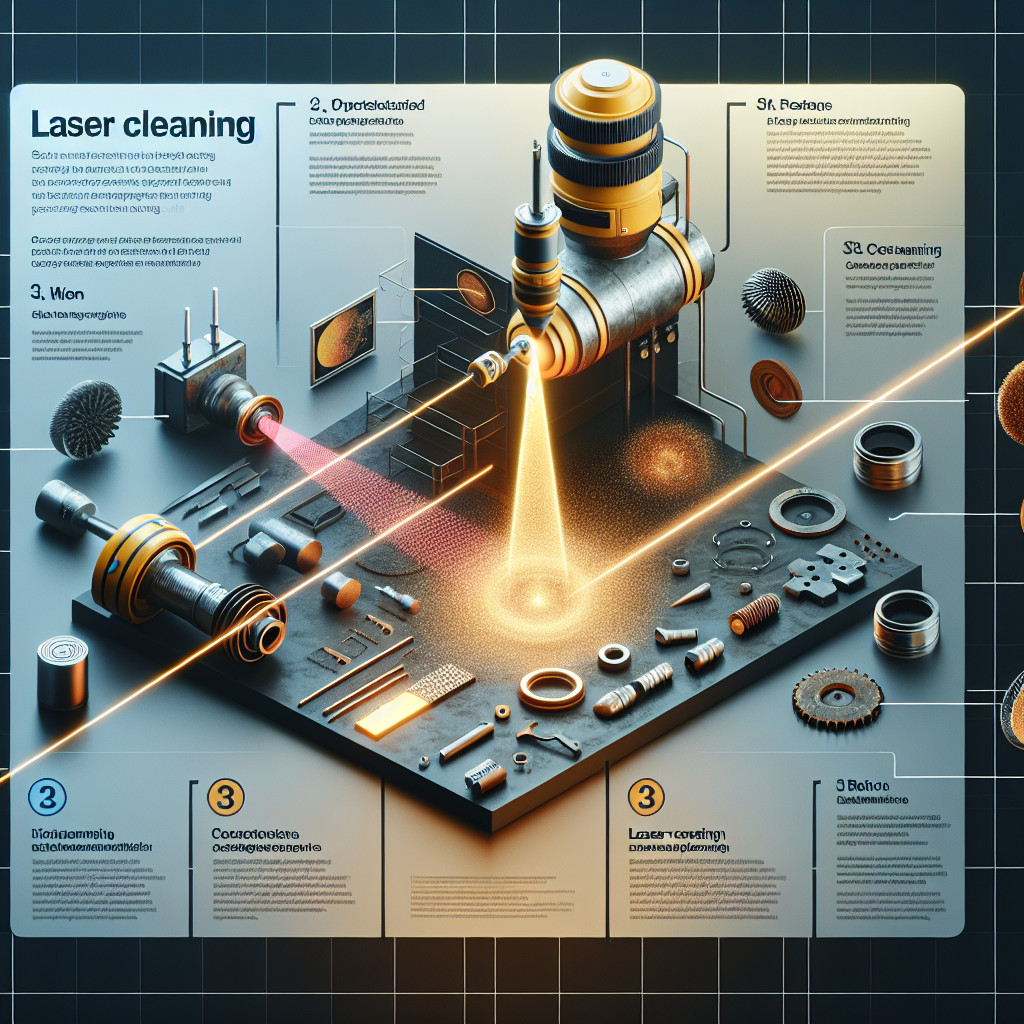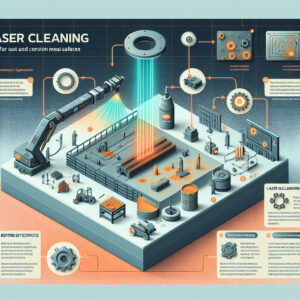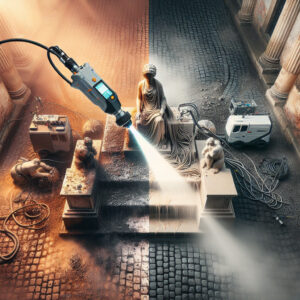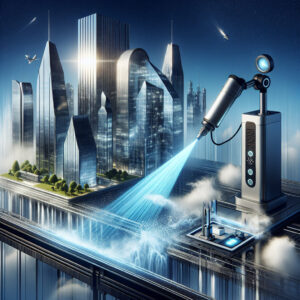- Benefits of Laser Cleaning for Metal Surfaces
- How Laser Cleaning Works on Rust and Corrosion
- Comparison of Laser Cleaning vs. Traditional Methods
- Applications of Laser Cleaning in Industrial Settings
- Advantages of Using Laser Technology for Surface Cleaning
Benefits of Laser Cleaning for Metal Surfaces
- Non-contact cleaning: Laser cleaning is a non-contact process, which means that there is no physical contact between the laser beam and the metal surface. This eliminates the risk of damage to the metal and ensures a clean and precise cleaning process.
- Environmentally friendly: Laser cleaning is an environmentally friendly method of cleaning metal surfaces. It does not require the use of chemicals or solvents, which reduces the amount of hazardous waste produced during the cleaning process. This makes laser cleaning a sustainable and eco-friendly option for metal surface cleaning.
- High precision: Laser cleaning is a highly precise method of cleaning metal surfaces. The laser beam can be controlled with great accuracy, allowing for precise removal of contaminants and coatings without damaging the underlying metal. This precision ensures a clean and uniform surface finish.
- Fast and efficient: Laser cleaning is a fast and efficient method of cleaning metal surfaces. The laser beam can remove contaminants and coatings quickly and effectively, reducing the time and labor required for cleaning. This results in increased productivity and cost savings for metal surface cleaning applications.
- Versatile: Laser cleaning is a versatile method that can be used on a wide range of metal surfaces, including steel, aluminum, copper, and more. It can be used to remove rust, paint, grease, and other contaminants from metal surfaces, making it a versatile cleaning solution for various industries.
- Safe and easy to use: Laser cleaning is a safe and easy-to-use method of cleaning metal surfaces. It does not require the use of harsh chemicals or abrasive materials, making it a safe option for workers and the environment. Additionally, laser cleaning equipment is easy to operate and maintain, making it a user-friendly cleaning solution.
In conclusion, laser cleaning offers several benefits for cleaning metal surfaces, including non-contact cleaning, environmental friendliness, high precision, speed and efficiency, versatility, and safety. This technology is a cost-effective and sustainable option for metal surface cleaning applications in various industries.
How Laser Cleaning Works on Rust and Corrosion
How Laser Cleaning Works
The laser cleaning process works by focusing a high-energy laser beam onto the surface of the material that needs to be cleaned. The laser beam heats up and vaporizes the rust and corrosion, causing it to be removed from the surface. The process is highly precise and can be controlled to remove only the rust and corrosion, leaving the underlying material intact.
There are two main types of laser cleaning methods: pulsed laser cleaning and continuous wave laser cleaning. Pulsed laser cleaning involves using short pulses of high-energy laser light to remove the rust and corrosion, while continuous wave laser cleaning uses a continuous beam of laser light to achieve the same result.
Benefits of Laser Cleaning
There are several benefits to using laser cleaning for rust and corrosion removal. Some of the key advantages include:
| Advantages | Description |
|---|---|
| Non-contact | Laser cleaning is a non-contact process, which means that there is no physical contact between the laser beam and the material being cleaned. This helps to prevent damage to the material and ensures a clean and precise result. |
| Environmentally friendly | Unlike traditional cleaning methods that use chemicals or abrasive materials, laser cleaning is environmentally friendly and does not produce any harmful by-products. This makes it a sustainable and eco-friendly option for rust and corrosion removal. |
| Highly precise | Laser cleaning is a highly precise process that can be controlled to remove only the rust and corrosion, leaving the underlying material intact. This precision helps to ensure a clean and uniform result. |
| Safe for use on a wide range of materials | Laser cleaning can be used on a wide range of materials, including metals, plastics, ceramics, and composites. This versatility makes it a versatile and effective option for rust and corrosion removal in various industries. |
Applications of Laser Cleaning
Laser cleaning is used in a wide range of industries for rust and corrosion removal. Some common applications include:
- Automotive industry: Laser cleaning is used to remove rust and corrosion from car parts, engines, and other components.
- Manufacturing industry: Laser cleaning is used to clean molds, tools, and equipment in manufacturing plants.
- Marine industry: Laser cleaning is used to remove rust and corrosion from ship hulls, propellers, and other marine equipment.
- Aerospace industry: Laser cleaning is used to clean aircraft components, engines, and other aerospace equipment.
Conclusion
Laser cleaning is a highly effective and efficient method for removing rust and corrosion from various surfaces. It offers several benefits, including non-contact operation, environmental friendliness, high precision, and versatility. With its wide range of applications, laser cleaning is a valuable tool for industries looking to maintain and restore their equipment and components.
Comparison of Laser Cleaning vs. Traditional Methods
Effectiveness
| Method | Effectiveness |
|---|---|
| Laser Cleaning | Highly effective in removing contaminants without damaging the surface |
| Sandblasting | Effective but can cause damage to delicate surfaces |
| Chemical Cleaning | Effective but may leave residues and require additional cleaning |
| Abrasive Blasting | Effective but can be abrasive and cause surface damage |
Efficiency
| Method | Efficiency |
|---|---|
| Laser Cleaning | Fast and precise, requires minimal setup and cleanup |
| Sandblasting | Can be time-consuming and messy, requires equipment setup and cleanup |
| Chemical Cleaning | May require multiple applications and drying time |
| Abrasive Blasting | Can be labor-intensive and time-consuming |
Cost
| Method | Cost |
|---|---|
| Laser Cleaning | Higher initial cost but lower long-term maintenance costs |
| Sandblasting | Lower initial cost but higher maintenance and material costs |
| Chemical Cleaning | Variable cost depending on the type and amount of chemicals used |
| Abrasive Blasting | Lower initial cost but higher material and equipment maintenance costs |
Environmental Impact
| Method | Environmental Impact |
|---|---|
| Laser Cleaning | Environmentally friendly, no chemicals or waste produced |
| Sandblasting | Can produce dust and waste materials, may require containment measures |
| Chemical Cleaning | Can produce hazardous waste and require proper disposal |
| Abrasive Blasting | Can produce dust and waste materials, may require containment measures |
Overall, laser cleaning offers a highly effective, efficient, and environmentally friendly alternative to traditional cleaning methods. While it may have a higher initial cost, the long-term benefits in terms of maintenance, efficiency, and environmental impact make it a worthwhile investment for many industries.
Applications of Laser Cleaning in Industrial Settings
Automotive Industry
In the automotive industry, laser cleaning is used to remove paint, rust, and other contaminants from car bodies, engine components, and other parts. This process is highly effective in preparing surfaces for painting, welding, and other manufacturing processes. Laser cleaning can also be used to remove adhesive residues from car windows, mirrors, and other surfaces.
| Application | Benefits |
|---|---|
| Paint removal | Efficient, precise, and environmentally friendly |
| Rust removal | Prevents corrosion and extends the lifespan of automotive components |
| Adhesive removal | Leaves surfaces clean and ready for further processing |
Aerospace Industry
In the aerospace industry, laser cleaning is used to remove coatings, oxides, and other contaminants from aircraft components, engine parts, and other critical surfaces. This process is essential for maintaining the performance, safety, and reliability of aerospace equipment. Laser cleaning can also be used to remove thermal barrier coatings from turbine blades and other high-temperature components.
| Application | Benefits |
|---|---|
| Coating removal | Preserves the integrity of aerospace components |
| Oxide removal | Improves the performance and longevity of aircraft parts |
| Thermal barrier coating removal | Ensures the proper functioning of high-temperature components |
Manufacturing Industry
In the manufacturing industry, laser cleaning is used to remove contaminants, scale, and other unwanted materials from metal, plastic, and other surfaces. This process is essential for ensuring the quality, precision, and reliability of manufactured products. Laser cleaning can also be used to prepare surfaces for welding, bonding, and other assembly processes.
| Application | Benefits |
|---|---|
| Contaminant removal | Improves the quality and appearance of manufactured products |
| Scale removal | Prevents corrosion and extends the lifespan of metal components |
| Surface preparation | Ensures proper adhesion and bonding of materials |
Conclusion
Laser cleaning is a versatile and effective technology that offers numerous benefits in industrial settings. From automotive and aerospace industries to manufacturing and beyond, laser cleaning is used to remove contaminants, coatings, rust, and other unwanted materials from surfaces. This process is essential for maintaining the performance, safety, and reliability of critical components and ensuring the quality, precision, and appearance of manufactured products.
Advantages of Using Laser Technology for Surface Cleaning
1. Precision Cleaning
- Laser technology allows for precise cleaning of surfaces, targeting specific areas without causing damage to surrounding materials. This level of precision is especially useful in industries where cleanliness is crucial, such as electronics manufacturing or medical device production.
- With laser technology, you can remove contaminants or coatings from surfaces with high accuracy, ensuring a thorough cleaning process.
2. Non-contact Cleaning
- Unlike traditional cleaning methods that involve physical contact with the surface, laser technology enables non-contact cleaning. This means that there is no risk of scratching or damaging delicate materials during the cleaning process.
- Non-contact cleaning also reduces the risk of contamination, as there is no need for cleaning agents or abrasive materials that can leave residues on the surface.
3. Environmentally Friendly
- Laser technology is an environmentally friendly cleaning solution, as it does not require the use of chemicals or solvents that can harm the environment. This makes it a sustainable option for industries looking to reduce their carbon footprint.
- By using laser technology for surface cleaning, you can eliminate the need for disposable cleaning materials, reducing waste and promoting a more eco-friendly cleaning process.
4. Cost-effective
- While the initial investment in laser technology may be higher than traditional cleaning methods, the long-term cost savings can be significant. Laser cleaning is a more efficient process that requires less time and labor, ultimately reducing cleaning costs over time.
- Additionally, laser technology is a versatile cleaning solution that can be used for a wide range of surfaces and materials, making it a cost-effective option for industries with diverse cleaning needs.
5. Safety
- Laser technology offers a safe cleaning solution, as it eliminates the need for manual labor and reduces the risk of accidents or injuries associated with traditional cleaning methods.
- With laser technology, operators can control the cleaning process remotely, minimizing exposure to hazardous materials or environments.
Overall, the are clear. From precision cleaning to cost savings and environmental benefits, laser technology offers a modern and efficient solution for industries looking to improve their cleaning processes.
- Sure! Here are some questions related to AI-powered features in Software for tracking employee hours: - 11 November 2025
- Sure! Here are some questions related to Employee monitoring software and workplace transparency: - 10 November 2025
- What Sylius is and what it is for - 25 October 2025



